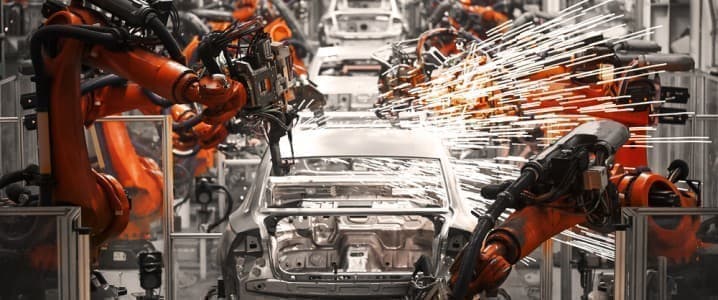Copyright OilPrice

The Automotive MMI (Monthly Metals Index) moved sideways, rising a slight 1.39%. As a whole, the US automotive market is facing a number of challenges necessitating both innovation and resilience. Why Are Critical EV Minerals in Short Supply? Automakers are grappling with shortages of critical minerals needed for electric vehicles and high-tech components. Rare earth minerals are a prime example. This set of 17 metallic elements is integral to many car parts, from EV motors and batteries to windshield wipers and speakers. CBS News reports that about 90% of the rare earths used by the US industry are sourced from China. This leaves the US automotive market highly dependent on foreign supply. In May, 2025, Ford Motor Co. had to temporarily halt production at its Chicago SUV plant due to a sudden shortage of rare earth magnets needed for electric power steering and other components. Chinese Control Over Rare Earths Remains a Key Problem Because China dominates the global rare earth supply chain, even a brief disruption can have a significant impact on the US automotive market. China also refines nearly 99% of the world’s heavy rare earth elements, resulting in a near-monopoly where any Chinese export curbs immediately ripple through manufacturing. According to EHN, US automakers recently warned that vehicle assembly could grind to a halt within weeks if rare earth shipments didn’t resume. The crisis prompted urgent trade talks. But as of October 2025, China announced even stricter rules, ultimately tying rare earth magnet exports to national security considerations. The lesson for US firms is clear: supply lines for critical EV minerals are vulnerable, and over-reliance on one country presents a significant strategic risk. What Strategies Are Automakers Using to Secure Materials? Facing the twin challenges of rising costs and scarce materials, US automakers are adopting new supply chain strategies to bolster resilience. Diversifying sourcing is priority number one, and manufacturers are seeking alternative suppliers for minerals outside of both China and traditional metal import channels. In some cases, companies are stockpiling critical parts and materials as a buffer. For instance, German automakers like BMW and Mercedes-Benz reportedly entered 2025 with plans to build inventories of rare earth magnets and other key components when China’s restrictions hit. This kind of inventory hedging can keep production running through short-term disruptions. Will the US Automotive Market and Car Makers Strike Lithium Gold in Nevada? Automakers are also taking a more hands-on approach to raw material supply. A notable example is General Motors’ investment of around $650 million in a Nevada lithium mine (Thacker Pass) to secure a domestic source of lithium for EV batteries. Other carmakers have signed long-term contracts with US and Australian mining firms for lithium, nickel and cobalt, all to ensure critical battery minerals remain available even if overseas supply chains falter. Related: U.S. Oil Growth Shifts from Shale to Gulf Another strategy that is proving key for the US automotive market is recycling and circular reuse of metals. Recycling not only reduces dependence on mined imports but also aligns with sustainability goals. Therefore, manufacturers across the US are partnering with specialized firms to reclaim materials from scrap and end-of-life batteries. For example, Ford recently invested $50 million in Redwood Materials, a Nevada-based company, to integrate battery recycling into its supply chain. By recycling old lithium-ion batteries, Redwood can provide Ford with a domestic stream of lithium, cobalt and nickel for new EV batteries. Companies like GM are also working with recyclers to harvest scrap from battery production for reuse. What’s the Outlook for US Metal Procurement in Auto Manufacturing? In the short term, volatility is the new normal. U.S. automotive procurement executives must continue to navigate unpredictable swings in both policy and supply. Tariffs can change with geopolitical winds, as exemplified by mid-2025’s rapid escalations and subsequent trade truces. Meanwhile, the critical mineral supply can be suddenly pinched by export controls abroad. This type of environment calls for a combination of vigilance and flexibility. For instance, many firms are strengthening their risk management by locking in fixed-price contracts for steel and aluminum where possible, while closely monitoring inventories of at-risk materials. Building resilience is the name of the game, and dual sourcing, strategic stockpiles, vertical integration and recycling are becoming standard tools in the procurement playbook. Not All Bad News On a hopeful note, ongoing negotiations and investments may alleviate some pressures. The US and EU recently implemented a trade agreement that lowers certain auto-related tariffs and even exempts some raw materials like rare earths and graphite from duties. Meanwhile, domestic capacity is inching upward. For example, new aluminum recycling facilities and steel mini-mills are coming online, and the Mountain Pass rare earth mine in California is increasing output. That said, the facility still ships its ore to China for processing, at least for now. Ultimately, CFOs and sourcing leaders in the US automotive market are balancing a tough equation. To keep assembly lines running and costs manageable tomorrow, they must invest in supply chain resilience today. Automotive MMI: Noteworthy Price Shifts Hot-dipped galvanized steel prices dropped 3.44% to $1,009 per short ton. Korean 5052 aluminum coil premium over 1050 prices moved sideways, dropping 2.19% to $4.09 per kilogram. Chinese lead prices moved sideways, rising just 0.59% to $2,359.32 per metric ton. Lastly, LME primary three-month copper prices rose by 5.54% to $10,332 per metric ton. By MetalMiner More Top Reads From Oilprice.com: India Rejects U.S. Claims of Halving Russian Oil Imports Citi Makes a Case for $50 Oil China’s Battery Giants Flood Overseas Markets As Exports Surge 220%



